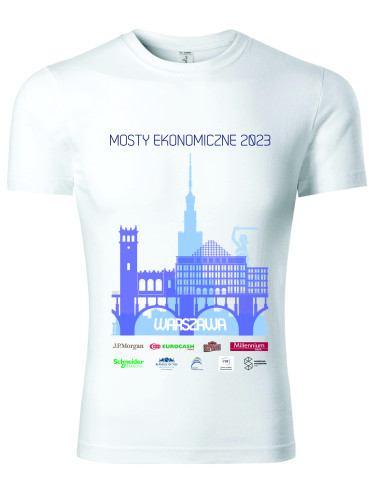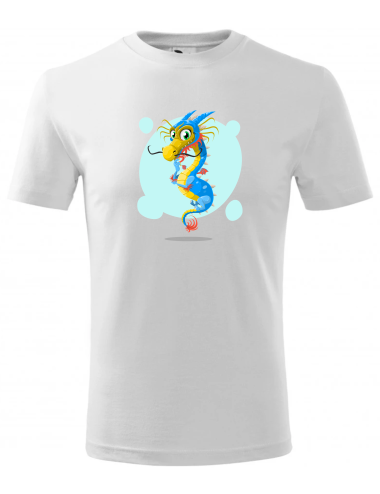DTG printing
How to order clothing with embroidery or logo printing
In the P&M online store you can order DTG prints on T-shirts and masks. Our professional digital printer and experienced employees guarantee durable and high-quality products with precisely reproduced colors, tonal gradations and even the smallest details. Our offer
DTG printing - a unique decoration technique, possibilities
DTG printing
DTG printing , i.e. direct printing on fabric, uses digital printing technology to apply graphics to clothing. This direct printing method allows you to obtain high-quality, durable and colorful patterns without the need to use additional templates. Thanks to DTG printing, personalization of prints on T-shirts, bags or other materials is quick and economical, which makes this method of marking prints on clothes increasingly popular among customers looking for unique and individually designed products. DTG printing step by step includes preparing the project, selecting the appropriate printed T-shirt and proper DTG printer settings, which guarantees perfect reproduction of colors and graphic details.
What is DTG printing?
DTG printing is a textile decorating process in which a specialized DTG printer directly applies ink to clothing. This technology enables the implementation of projects with a rich color palette and complex patterns without the need to create matrices. DTG printing is especially recommended for short series and individual orders, making it ideal for the needs of the textile decoration market. This process is also characterized by a short turnaround time and the ability to print on various types of fabrics, which makes it an attractive choice for companies and individual customers.
DTG printing defects
Despite many advantages, DTG printing also has some limitations. The disadvantages of DTG printing include higher production costs for very small quantities and limitations related to the durability of the print compared to traditional methods, such as screen printing . For best results, it is recommended to use prints on cotton materials, which may be a limitation for some projects. Despite these challenges, the continuous development of DTG printing technology and the improvement of inks and machines allows us to minimize these inconveniences, while offering the highest quality digital prints, durable prints and flexibility in project implementation.
Advantages of DTG printing
The possibilities of DTG printing include, above all, exceptional precision, the ability to make full-color prints, multi-color designs, and production speed and flexibility. Thanks to DTG printing technology, even the most complex patterns are reproduced while maintaining the richness of details and color depth. This method allows you to personalize single pieces and small series without additional production preparation costs, which makes it an ideal solution for individual orders, design projects or trial editions. DTG digital printing is also environmentally friendly as it minimizes waste and water consumption compared to traditional printing methods.
Is the DTG print permanent?
The durability of a DTG print depends on several factors, such as the quality of the inks used, the type of fabric and proper care of the clothing. DTG printing technology is constantly developing, offering better and better solutions that ensure high durability of prints. To maximize the quality of the print, it is recommended to use gentle washing programs and avoid direct exposure to high temperatures when ironing. Thanks to these treatments, DTG prints can maintain their quality for a long time, delighting users with the intensity of colors and clarity of graphics.
What is the difference between DTG printing and other printing methods?
DTG printing differs from traditional printing methods, such as screen printing or transfer, primarily by directly applying ink to the fabric, which eliminates the need to create additional matrices or transfer foils. This digital printing technology allows for greater flexibility in design and order fulfillment, allowing for easy personalization and quick pattern changes at no additional cost. DTG printing is also more ecological, reducing waste and water consumption. This printing method is particularly advantageous when producing small quantities and single copies, while offering high quality and durability.
What materials are suitable for DTG printing?
DTG printing works best on cotton fabrics and cotton blends, which provide optimal conditions for ink absorption and its durability. These materials are characterized by good color absorption properties, which translates into expressive and durable prints. Although DTG technology is primarily designed to work with cotton, advances in inks and material processing allow for an expansion of the range of fabrics suitable for printing, including viscose and some synthetics. Choosing the right material is crucial to obtaining satisfactory printing results, therefore, before implementing the project, it is recommended to consult with experts to adapt the technique to a specific type of fabric.
DTG digital printing technology: Modernity and precision
Thanks to advanced digital DTG technology, direct DTG printing, our company P&M Rawa Mazowiecka provides the highest quality products, characterized by faithfully reproduced colors and details thanks to DTG printing. The use of a modern Brother GTXpro Bulk printer allows for unrivaled precision and speed in order processing, which makes DTG digital printing the preferred choice for demanding customers.
Simple project preparation process
Preparing a design using direct DTG printing is much simpler than traditional decorating methods. It does not require the creation of additional matrices or templates, which significantly shortens the preparation time and allows for easy adaptation of the project to the individual needs of the client. The high resolution of the delivered graphics guarantees that the final product will be a reproduction of the graphics and reflect the intended vision with the smallest details.
Implementation of DTG printing step by step
Placing an order for DTG printing in our store is intuitive and transparent. We offer full support at every stage - from product selection, through sending a graphic design, to finalizing the order. Our PM Rawa team is always ready to help and advise, ensuring your complete satisfaction with the product you receive.
DTG printing technique: Basics
The basic DTG printing technique involves directly transferring ink to the fabric using a specialized printer. DTG printing design. This DTG technique enables the implementation of both simple and complex DTG printing designs, while maintaining high quality and color fidelity. Printing on clothing using this method is durable and resistant to washing.
DTG printing process
The process of applying a DTG print begins with careful preparation of the fabric and loading the design to the printer. Specialized print heads apply ink directly to the material, which is then fixed to ensure the durability and resistance of the graphics. This modern approach guarantees excellent results while maintaining ecological production standards.
Why is it worth choosing DTG printing?
choosing DTG digital printing is a decision to choose high quality, personalization and care for the environment. This method allows you to implement individual ideas while maintaining attractive prices and short implementation times, which makes it a perfect solution for both business and individual customers looking for unique products.
Advantages and challenges of DTG printing
DTG clothing printing is distinguished by high quality, precision of workmanship and the possibility of implementing full-color projects. It is also an ecological alternative to traditional decorating methods. Limitations such as higher costs for small quantities or specific fabric requirements are systematically minimized thanks to the continuous development of technology and optimization of production processes. Our offer provides a wide selection of products and flexible ordering options to meet the expectations of even the most demanding customers.


















